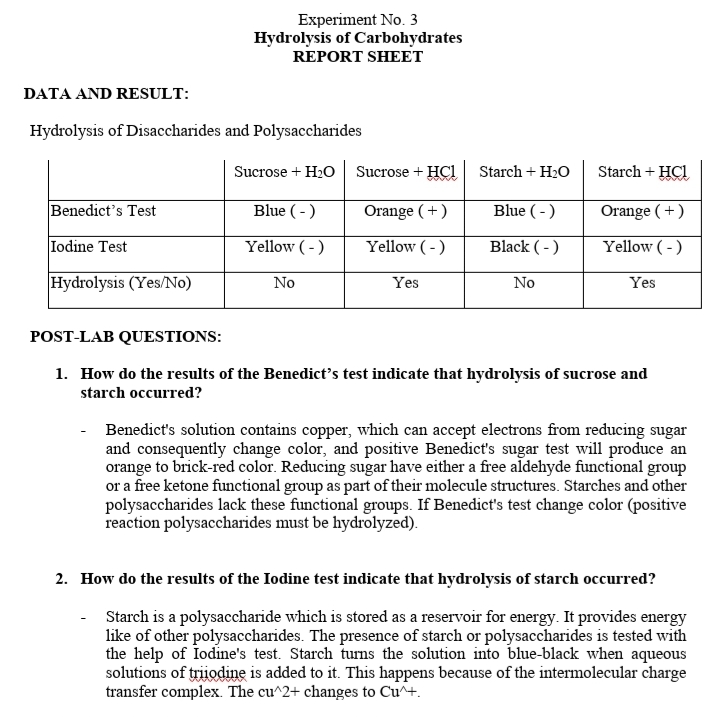1. How do the results of the Benedict's test indicate that hydrolysis of sucrose and starch occurred? Benedict's solution contains copper, which can accept electrons from reducing sugar and consequently change color, and positive Benedict's sugar test will produce an orange to brick-red color. Reducing sugar have either a free aldehyde functional group or a free ketone functional group as part of their molecule structures. Starches and other polysaccharides lack these functional groups. If Benedict's test change color (positive reaction polysaccharides must be hydrolyzed). 2. How do the results of the Iodine test indicate that hydrolysis of starch occurred? Starch is a polysaccharide which is stored as a reservoir for energy. It provides energy like of other polysaccharides. The presence of starch or polysaccharides is tested with the help of Iodine's test. Starch tums the solution into blue-black when aqueous solutions of triiodine is added to it. This happens because of the intermolecular charge transfer complex. The cu^2+ changes to Cu^+.
1. How do the results of the Benedict's test indicate that hydrolysis of sucrose and starch occurred? Benedict's solution contains copper, which can accept electrons from reducing sugar and consequently change color, and positive Benedict's sugar test will produce an orange to brick-red color. Reducing sugar have either a free aldehyde functional group or a free ketone functional group as part of their molecule structures. Starches and other polysaccharides lack these functional groups. If Benedict's test change color (positive reaction polysaccharides must be hydrolyzed). 2. How do the results of the Iodine test indicate that hydrolysis of starch occurred? Starch is a polysaccharide which is stored as a reservoir for energy. It provides energy like of other polysaccharides. The presence of starch or polysaccharides is tested with the help of Iodine's test. Starch tums the solution into blue-black when aqueous solutions of triiodine is added to it. This happens because of the intermolecular charge transfer complex. The cu^2+ changes to Cu^+.
Biochemistry
9th Edition
ISBN:9781319114671
Author:Lubert Stryer, Jeremy M. Berg, John L. Tymoczko, Gregory J. Gatto Jr.
Publisher:Lubert Stryer, Jeremy M. Berg, John L. Tymoczko, Gregory J. Gatto Jr.
Chapter1: Biochemistry: An Evolving Science
Section: Chapter Questions
Problem 1P
Related questions
Question
100%
Make a CONCLUSION

Transcribed Image Text:Experiment No. 3
Hydrolysis of Carbohydrates
REPORT SHEET
DATA AND RESULT:
Hydrolysis of Disaccharides and Polysaccharides
Sucrose + H2O Sucrose + HCI
Starch + H2O
Starch + HCI
Benedict's Test
Blue (-)
Orange (+)
Blue ( - )
Orange (+)
Iodine Test
Yellow (-)
Yellow (-)
Black ( - )
Yellow (-)
Hydrolysis (Yes/No)
No
Yes
No
Yes
POST-LAB QUESTIONS:
1. How do the results of the Benedict's test indicate that hydrolysis of sucrose and
starch occurred?
Benedict's solution contains copper, which can accept electrons from reducing sugar
and consequently change color, and positive Benedict's sugar test will produce an
orange to brick-red color. Reducing sugar have either a free aldehyde functional group
or a free ketone functional group as part of their molecule structures. Starches and other
polysaccharides lack these functional groups. If Benedict's test change color (positive
reaction polysaccharides must be hydrolyzed).
2. How do the results of the Iodine test indicate that hydrolysis of starch occurred?
Starch is a polysaccharide which is stored as a reservoir for energy. It provides energy
like of other polysaccharides. The presence of starch or polysaccharides is tested with
the help of Iodine's test. Starch turns the solution into blue-black when aqueous
solutions of triiodine is added to it. This happens because of the intermolecular charge
transfer complex. The cu^2+ changes to Cu^+.
Expert Solution
This question has been solved!
Explore an expertly crafted, step-by-step solution for a thorough understanding of key concepts.
This is a popular solution!
Trending now
This is a popular solution!
Step by step
Solved in 3 steps

Recommended textbooks for you

Biochemistry
Biochemistry
ISBN:
9781319114671
Author:
Lubert Stryer, Jeremy M. Berg, John L. Tymoczko, Gregory J. Gatto Jr.
Publisher:
W. H. Freeman

Lehninger Principles of Biochemistry
Biochemistry
ISBN:
9781464126116
Author:
David L. Nelson, Michael M. Cox
Publisher:
W. H. Freeman

Fundamentals of Biochemistry: Life at the Molecul…
Biochemistry
ISBN:
9781118918401
Author:
Donald Voet, Judith G. Voet, Charlotte W. Pratt
Publisher:
WILEY

Biochemistry
Biochemistry
ISBN:
9781319114671
Author:
Lubert Stryer, Jeremy M. Berg, John L. Tymoczko, Gregory J. Gatto Jr.
Publisher:
W. H. Freeman

Lehninger Principles of Biochemistry
Biochemistry
ISBN:
9781464126116
Author:
David L. Nelson, Michael M. Cox
Publisher:
W. H. Freeman

Fundamentals of Biochemistry: Life at the Molecul…
Biochemistry
ISBN:
9781118918401
Author:
Donald Voet, Judith G. Voet, Charlotte W. Pratt
Publisher:
WILEY

Biochemistry
Biochemistry
ISBN:
9781305961135
Author:
Mary K. Campbell, Shawn O. Farrell, Owen M. McDougal
Publisher:
Cengage Learning

Biochemistry
Biochemistry
ISBN:
9781305577206
Author:
Reginald H. Garrett, Charles M. Grisham
Publisher:
Cengage Learning

Fundamentals of General, Organic, and Biological …
Biochemistry
ISBN:
9780134015187
Author:
John E. McMurry, David S. Ballantine, Carl A. Hoeger, Virginia E. Peterson
Publisher:
PEARSON